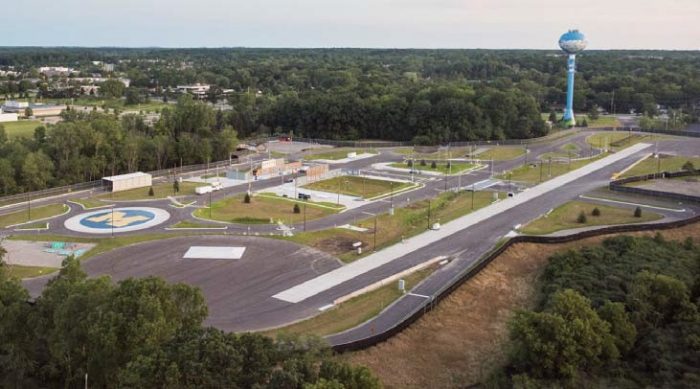The role of ITS is to balance between providing campus with dependable services at scale and enabling innovative research and discovery. The exciting work happening at the Mcity Test Facility falls squarely into the latter.
This one-of-a-kind test facility is operated by Mcity, a public-private partnership led by U-M to accelerate advanced mobility vehicles and technologies. Mcity is helping to lead the way to a future of connected and automated vehicles. Keyword: connected. In partnership with Mcity, ITS has laid the groundwork of a deeply connected fiber optic infrastructure at the Mcity Test Facility that enables the cutting-edge transportation research happening there, not to mention the vast amount of data it generates.
But it’s not just about transportation. “The Mcity Test Facility is designed like a real small city, and therefore is ideally suited for research in other areas, including the Internet of Things (IoT), smart cities, and more,” said Huei Peng, director of Mcity, and the Roger L. McCarthy Professor of Mechanical Engineering at the College of Engineering.
He envisions a future for the test facility beyond its much-applauded research work on transportation implications. “We look forward to working with ITS on exploring many of these advancements,” he said.
Peng and his team are leading efforts to facilitate research that rely on the high-speed network capabilities. How much research? Mcity is open to researchers seven days a week, and weekdays are typically 100 percent booked about two months in advance by researchers from U-M and some of the 70 industry members of Mcity who use the infrastructure. The breakdown so far this year: 60 percent research and 40 percent industry.
Driverless shuttles
This fall, Mcity plans to launch a driverless shuttle service on North campus. Two shuttles will transport students, faculty, and staff on a non-stop, two-mile route between the Lurie Engineering Center and the university’s North Campus Research Complex. According to Greg McGuire, lab director for Mcity, “these shuttles will connect to the university network to collect sensor data. The shuttles will also gather data about usage by allowing riders to connect to the U-M wireless network, MWireless, as they ride across campus.”
Data collected from the shuttle will be studied to draw conclusions on user acceptance of driverless vehicles, user behavior while using them, and the interesting interactions between these vehicles and other people on the road. Mcity is working with J.D. Power and Associates and ITS to survey people using the shuttle, and those who interact with the shuttle, such as pedestrians, bicyclists and drivers.
Focus on research
Peng added, “Imagine a future when there is WiFi on every campus, in every parking lot, and we know how many faculty members use those spaces. A future where researchers have access to operational data that allows them to understand the ebb and flow of traffic across campus in a privacy-preserving way. If we can integrate systems that understand where people are with advanced transportation systems, then we can improve the efficiency and effectiveness of such systems.”
According to Eric Boyd, director of research networks for ITS Infrastructure, “ITS is working in concert with researchers to design such systems that allow the development of applications and the asking of research questions against the university’s operational data in just such privacy-preserving way.” More innovative networking is planned for MCity coming over the year.
It is not just research enabling technology that ITS is providing to MCity. ITS is giving MCity a technology upgrade on everything from MiWorkspace enabled desktop solutions, to storage.
![]()
Ken Caldwell (ITS Communications) contributed to this story.
![]()
Patty Giorgio (ITS Communications) contributed to this story.

